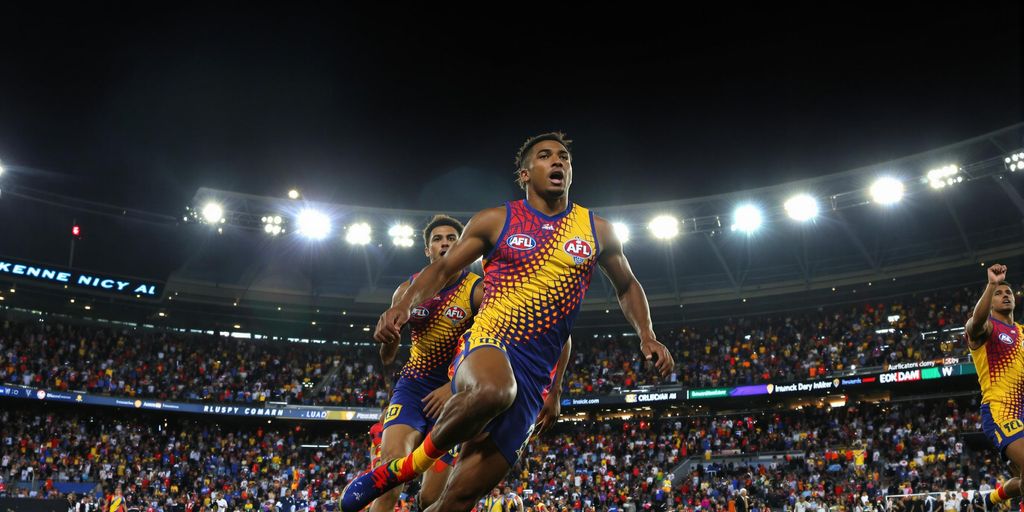Significance Of The AFL All Stars 2025
The 2025 AFL All Stars match is shaping up to be more than just another game of footy. It’s a chance to really celebrate Indigenous culture and the massive contribution Indigenous players have made, and continue to make, to the sport we all love. After a bit of a break, the return of the Indigenous All Stars is a big deal.
Honouring Indigenous Heritage
This match is a fantastic way to acknowledge and celebrate the rich heritage of Aboriginal and Torres Strait Islander peoples. It provides a platform to showcase their traditions, stories, and connection to the land through the medium of Australian Rules Football. It’s about recognising the unique cultural identity that these players bring to the game.
Promoting Cultural Awareness
Beyond just a celebration, the All Stars game is a great opportunity to boost cultural awareness among players, fans, and the wider community. It helps to educate people about Indigenous history, culture, and the challenges that Indigenous Australians still face. Hopefully, it encourages a more inclusive and understanding environment within the AFL and society in general. The Bulldogs face challenges with key player injuries, highlighting the need for squad depth and resilience.
Inspiring Future Generations
One of the most important aspects of the All Stars match is its potential to inspire young Indigenous kids to chase their dreams. Seeing their role models excel on the big stage can be incredibly powerful, showing them that anything is possible with hard work and dedication. It’s about creating pathways and opportunities for the next generation of Indigenous footballers.
This game isn’t just about the present; it’s about building a stronger future for Indigenous players in the AFL and ensuring that their contributions are recognised and valued for years to come. It’s about leaving a lasting legacy that inspires generations to come.
The Return Of The Indigenous All Stars
History Of The All Stars
The Indigenous All Stars concept isn’t new; it’s got a pretty rich history. Back in the day, these games were a massive deal, showcasing some seriously amazing talent and celebrating Indigenous culture within footy. It was more than just a game; it was a chance to see some of the best Indigenous players in the AFL come together and represent their heritage. Think of it as a cultural showcase on the footy field, a real celebration of skill and identity.
Impact Of The Hiatus
It’s been a long time between drinks, hasn’t it? The hiatus since the last Indigenous All Stars game in 2015 definitely left a void. The absence meant fewer opportunities to celebrate Indigenous players and culture on a national stage. It also meant less visibility for up-and-coming Indigenous talent, and a missed chance to inspire the next generation. It’s like the volume got turned down on a really important conversation. The break also impacted the support networks for Indigenous players, something the AFL needs to address.
Resurgence In 2025
But guess what? It’s back! The Indigenous All Stars are making a comeback in 2025, and it’s huge news. The Toyota AFL Indigenous All Stars Match against Fremantle at Optus Stadium is set to be a ripper. It’s not just about footy; it’s about reigniting that spark, celebrating Indigenous culture, and giving these players the recognition they deserve. It’s a chance to remind everyone of the incredible contribution Indigenous players have made, and continue to make, to Australian Rules. The return of the All Stars is a big step towards AFL inclusion.
This resurgence is more than just a game; it’s a statement. It’s about acknowledging the past, celebrating the present, and building a stronger, more inclusive future for Indigenous players in the AFL.
Here’s what you can expect:
- A showcase of top Indigenous talent.
- Celebration of Indigenous culture through art, music, and ceremony.
- A chance to inspire young Indigenous players.
Key Players To Watch In 2025
Rising Stars Of The Game
There’s a heap of young Indigenous talent coming through the ranks, and 2025 is shaping up to be a breakout year for some of them. Keep an eye on players like… well, I can’t name names just yet, but the Diversity All Stars matches are a great place to spot them! These young guns are hungry and ready to make a name for themselves. The Victorian Diversity All Stars matches, held on April 16th, showcased some serious potential. It’s all about seeing who can step up and grab the opportunity.
Veteran Leaders
It’s not just about the new kids, though. We’ve got some established Indigenous players who are absolute legends of the game. These blokes have been around the block, and their experience is invaluable. They’re the ones who lead by example, both on and off the field. They mentor the younger players and show them what it means to represent their culture with pride. They’re the backbone of their teams, and their leadership will be crucial in 2025.
Diversity In Talent
What’s awesome about the Indigenous All Stars is the sheer variety of skills on display. You’ve got your high-flying marksmen, your tough-as-nails defenders, and your silky-smooth midfielders. It’s a real showcase of the different ways Indigenous players contribute to the game.
It’s not just about kicking goals; it’s about the passion, the skill, and the cultural pride that these players bring to the field. The Indigenous All Stars match is a celebration of that diversity, and it’s what makes it such a special event.
Here’s a quick look at the different positions and skills we can expect to see:
- Speed and agility in the forward line.
- Strength and determination in the backline.
- Vision and creativity in the midfield.
Indigenous Representation In The AFL
Current Statistics
The AFL has made strides in Indigenous representation, but there’s still work to be done. While off-field staff numbers have increased, the number of Indigenous players on the field has actually decreased in recent years. In 2020, there were 95 young Indigenous men playing in the AFL, but that number has fallen to 63. Only two Indigenous players were picked at the last national draught. Daniel Rioli’s Gold Coast sits at the upper end of AFL clubs with six Indigenous players. It’s a mixed bag, and the numbers tell a story of both progress and setbacks. It’s important to keep an eye on these trends to ensure the AFL is truly inclusive.
Historical Contributions
Indigenous players have made an indelible mark on Australian Football since its inception. From trailblazers like Sir Doug Nicholls to modern-day stars, their contributions are woven into the very fabric of the game. Their athleticism, skill, and unique playing styles have enriched the sport and captivated fans for generations. It’s not just about on-field performance; Indigenous players have also served as role models and cultural ambassadors, inspiring countless young people to pursue their dreams. The Indigenous All-Stars game was resurrected in February this year after a decade in the wilderness.
Challenges Faced
Despite the contributions, Indigenous players continue to face challenges within the AFL system. These can range from racism and cultural misunderstandings to a lack of adequate support structures. It’s crucial to acknowledge these hurdles and work towards creating a more inclusive and equitable environment for all players. The AFL has implemented policies to combat racial vilification, but more needs to be done to address systemic issues and ensure that Indigenous players feel valued and respected. The infrastructure and support network from head office and across the competition to ensure Indigenous talent remains nurtured and treasured has fallen away dramatically.
The AFL must commit to providing better pathways and support for Indigenous players. This includes investing in grassroots programmes, providing culturally sensitive mentoring, and addressing issues of racism and discrimination. Only by tackling these challenges head-on can the AFL truly celebrate and support its Indigenous talent.
Here’s a quick look at some key areas needing attention:
- Improved pathways from junior levels
- Increased cultural awareness training for all players and staff
- Stronger support networks for Indigenous players and their families
Community Engagement And Support

Role Of Local Clubs
Local footy clubs are the heart and soul of many communities, and they play a huge role in supporting Indigenous players. They’re often the first point of contact for young players, providing a safe and inclusive environment to learn and grow. These clubs are vital for nurturing talent and fostering a sense of belonging. Think about it – these clubs aren’t just about footy; they’re about community. They run programmes, organise events, and provide support networks that extend far beyond the field. They are the bedrock for AFL Membership.
Involvement Of Indigenous Communities
Getting Indigenous communities actively involved is super important. It’s not just about having players on the field; it’s about having families, elders, and community leaders involved in every aspect of the game. This means creating opportunities for Indigenous people to take on coaching roles, administrative positions, and leadership roles within clubs and organisations. Community involvement ensures that the game reflects and respects Indigenous culture and values. It’s about making sure everyone feels welcome and valued.
Partnerships With Sponsors
Sponsors can play a big part in supporting Indigenous footy initiatives. It’s not just about throwing money at the problem; it’s about forming genuine partnerships that create lasting change. This could involve funding programmes that support Indigenous youth, providing scholarships for aspiring players, or investing in community development projects.
Sponsors need to be more than just logos on jerseys; they need to be active participants in promoting Indigenous inclusion and reconciliation. It’s about working together to create a more equitable and inclusive sporting landscape.
Here are some ways sponsors can help:
- Providing financial support for Indigenous-led initiatives.
- Creating employment opportunities for Indigenous people.
- Promoting cultural awareness through their marketing campaigns.
Cultural Celebrations During The Match
Traditional Ceremonies
It’s not just about the footy; it’s a chance to really showcase Indigenous culture. Expect to see traditional smoking ceremonies before the game, welcoming everyone to the land. These ceremonies are a sign of respect and a way to cleanse the space, setting a positive tone for the match. There will also be a Welcome to Country, delivered by an Elder, acknowledging the traditional owners of the land where the game is being played. These ceremonies are a powerful reminder of the deep connection Indigenous Australians have with the land.
Art And Music Contributions
Indigenous art and music will be front and centre. Local artists will be displaying their work, and there’ll be live music performances featuring Indigenous musicians. Think vibrant colours and powerful stories told through song and dance. The halftime show will be a real highlight, with a performance that blends traditional and contemporary styles. It’s a great way to get everyone involved and celebrate the diversity of Indigenous culture.
Cultural Education Initiatives
The All Stars match isn’t just entertainment; it’s also a chance to learn. There will be information booths set up where people can learn about Indigenous history, culture, and achievements.
- Educational displays about the Stolen Generations.
- Interactive workshops teaching traditional art techniques.
- Storytelling sessions with Elders sharing their knowledge.
It’s all about promoting understanding and respect. The AFL is working with Indigenous communities to make sure the information is accurate and respectful. They want to create a space where everyone can learn and appreciate the richness of Indigenous culture.
The Role Of Coaches And Mentors

Indigenous Coaches In The AFL
It’s no secret that footy clubs thrive when they have a strong culture, and Indigenous coaches play a massive part in building that. But let’s be real, the numbers aren’t great. In 2024, Xavier Clarke was the only Indigenous coach among all 18 clubs after he moved from Richmond to North Melbourne. That’s just not good enough. We need more Indigenous voices shaping the game from the sidelines, bringing their unique perspectives and leadership to the table. It’s about time we saw a real change here.
Mentorship Programmes
Mentorship programmes are super important for young Indigenous players trying to make their mark in the AFL. These programmes provide guidance, support, and a sense of belonging, helping these young talents navigate the challenges of professional footy. Think about it – having someone who understands your background, your culture, and the hurdles you face can make all the difference. These mentors aren’t just coaches; they’re role models, confidantes, and advocates. They help build confidence and resilience, ensuring these players not only survive but thrive in the AFL environment.
Developing Future Leaders
Developing future Indigenous leaders in the AFL is about more than just finding talented players; it’s about nurturing their potential both on and off the field. This means providing opportunities for leadership development, encouraging them to take on roles within their clubs and communities, and supporting their personal growth. It’s about creating a pathway for them to become role models and mentors themselves, inspiring the next generation of Indigenous footballers. The 2025 AFL ladder will be influenced by the quality of leadership within each team.
It’s about investing in their education, providing access to resources, and creating a supportive environment where they can thrive. By empowering these young leaders, we’re not just strengthening the AFL; we’re building a stronger, more inclusive community for everyone.
Here are some key areas to focus on:
- Leadership training programmes
- Educational opportunities
- Community engagement initiatives
AFL’s Commitment To Inclusion
The AFL has been making strides, but there’s still a fair way to go when it comes to genuine inclusion. It’s not just about having Indigenous players on the field; it’s about creating a supportive environment where they can thrive, and ensuring there are pathways for future generations.
Policies For Indigenous Players
The AFL has put policies in place aimed at supporting Indigenous players. These policies cover a range of areas, from cultural awareness training for clubs to guidelines on how to handle racial vilification. The Peek Rule, introduced after the racial abuse of Michael Long, was a landmark moment. However, policies alone aren’t enough; they need to be actively enforced and regularly reviewed to ensure they’re actually making a difference.
Support Programmes
There are a few support programmes in place, but the effectiveness of these programmes is often debated. Some argue that the resources aren’t allocated properly, leading to a drop in the number of Indigenous players coming through the ranks. More needs to be done to ensure these programmes are well-funded and tailored to meet the specific needs of Indigenous players. It’s about more than just football; it’s about education, health, and cultural identity.
Future Goals
The AFL talks a good game about its future goals for inclusion, but it’s the actions that matter. We need to see a real commitment to increasing the number of Indigenous coaches, administrators, and board members. It’s about having Indigenous voices at all levels of the game, not just on the field. The goal should be to create a truly inclusive environment where everyone feels valued and respected.
The AFL needs to move beyond symbolic gestures and implement meaningful change. This means investing in grassroots programmes, providing better support for Indigenous players, and holding clubs accountable for creating inclusive environments. It’s about walking the walk, not just talking the talk.
Fan Engagement And Experience
Ticketing Information
Alright, so you wanna snag some tickets for the AFL All Stars 2025? Good thinking! Ticketing will be available online through Ticketmaster and directly at the stadium on match day, but honestly, buying ahead is the way to go. Prices will vary depending on seating, with family packages and concession rates up for grabs. Keep an eye on the AFL website for the official release date – they usually drop a few months beforehand. Don’t snooze on it; these games are popular, and you don’t want to miss out!
Match Day Activities
Match day is gonna be huge! Expect a real festival atmosphere around the stadium. There’ll be face painting, food trucks galore (think gourmet snags and loaded fries), and live music pumping. Before the game, there’s usually a Welcome to Country ceremony, which is always pretty special. During breaks, keep an eye out for giveaways and interactive games on the big screen. It’s more than just footy; it’s a whole day out. Here’s a quick rundown:
- Welcome to Country ceremony
- Live music performances
- Food trucks and beverage stalls
- Face painting and kids’ activities
- Giveaways and on-screen entertainment
Community Involvement
This game is all about bringing people together. Local Indigenous communities will be heavily involved, with representatives participating in pre-match ceremonies and cultural performances. There’ll also be opportunities to support Indigenous charities and organisations through merchandise sales and donation points around the stadium. It’s a chance to celebrate Indigenous culture and contribute to a good cause. The AFL is working closely with community leaders to make sure everyone feels welcome and included. It’s a great way to show your support and learn more about Australian football‘s deep connection to Indigenous heritage.
The AFL All Stars game isn’t just about the footy; it’s about celebrating culture, supporting communities, and creating a memorable experience for everyone involved. It’s a chance to come together, show respect, and enjoy a fantastic day out.
Media Coverage And Promotion
Broadcasting The Event
The Indigenous All Stars match in 2025 is set to receive extensive coverage. Expect to see it broadcast on free-to-air television, likely with pre-game and post-game analysis. Pay-TV channels will also be in the mix, offering high-definition coverage and alternative commentary options. Radio stations, both national and local, will provide live commentary, catering to fans on the move. The goal is to make the game accessible to everyone, no matter where they are. Collingwood’s victory boosted the Friday night ratings for the Seven Network.
Social Media Campaigns
Social media will play a huge role in promoting the Indigenous All Stars game. Expect dedicated hashtags, player interviews, behind-the-scenes content, and interactive polls. The AFL and associated media outlets will be pushing content across all platforms, including Facebook, Instagram, TikTok, and X. Fan engagement will be key, with opportunities to share their experiences and show their support. The use of social media aims to reach a younger audience and create a buzz around the event.
Highlighting Indigenous Stories
Beyond just the game itself, the media coverage will focus on the stories of Indigenous players, coaches, and community members. These stories will explore their journeys, their challenges, and their achievements. The goal is to celebrate Indigenous culture and provide a platform for these voices to be heard. This includes:
- Player profiles showcasing their backgrounds and inspirations.
- Interviews with elders and community leaders about the importance of the game.
- Documentaries exploring the history of Indigenous involvement in the AFL.
It’s about more than just football; it’s about recognising the contribution of Indigenous people to Australian society.
Legacy Of The Indigenous All Stars
Building A Stronger Future
The Indigenous All Stars game isn’t just a match; it’s an investment in the future. It’s about showing young Indigenous kids that they can achieve anything, on and off the field. The game provides a platform for role models, demonstrating the heights that can be reached through dedication and hard work. It’s about building resilience and creating pathways for the next generation of Indigenous talent to shine. It’s about more than just footy; it’s about life.
Continuing The Tradition
This game is more than just a one-off event; it’s about keeping a tradition alive. It’s about remembering the past, celebrating the present, and looking forward to the future. The Indigenous All Stars game is a chance to honour the legacy of those who came before, the players who paved the way and fought for recognition. It’s a reminder that the journey is ongoing, and that each generation has a responsibility to carry the torch forward.
Impact On Australian Football
The impact of the Indigenous All Stars extends far beyond the field. It’s about shaping the culture of Australian football, making it more inclusive and representative of the diverse communities that make up this country. The game challenges stereotypes, promotes understanding, and celebrates the unique contributions of Indigenous players. It’s a reminder that footy is for everyone, and that the game is richer and stronger because of the involvement of Indigenous Australians. The Indigenous All Stars game is a powerful symbol of unity and reconciliation, showing that sport can be a force for positive change.
The Indigenous All-Stars game serves as a reminder of the ongoing need for support and infrastructure to ensure Indigenous talent is nurtured and treasured within the AFL. It highlights the importance of cultural awareness and the need to address past and present challenges faced by Indigenous players. It’s a call to action for the AFL to continue its commitment to inclusion and to create a more equitable and supportive environment for all.
Looking Ahead: The Future of Indigenous Talent in AFL
As we wrap up our look at the 2025 AFL Indigenous All Stars, it’s clear this event is more than just a game. It’s a chance to celebrate the rich culture and talent of Indigenous players who’ve shaped our sport. With the return of the All Stars, we’re reminded of the importance of supporting Indigenous pathways in footy. Sure, there are challenges ahead, but the excitement and pride from players and fans alike show that there’s a bright future. Let’s hope this sparks more opportunities for young Indigenous talent to shine on the big stage. Here’s to celebrating our past while looking forward to a more inclusive future in Australian football.




